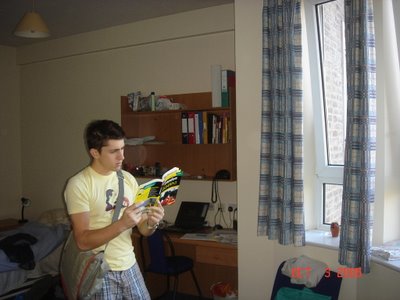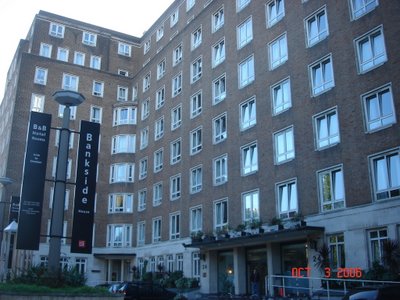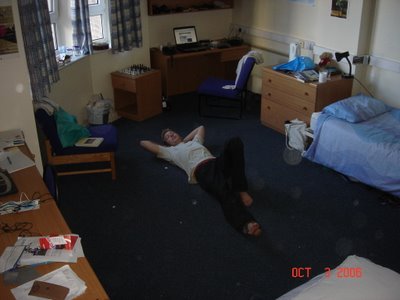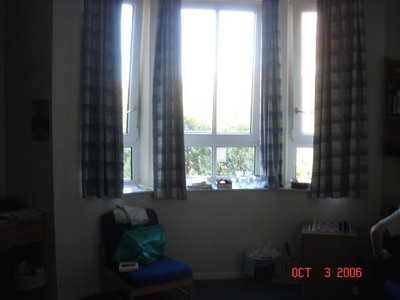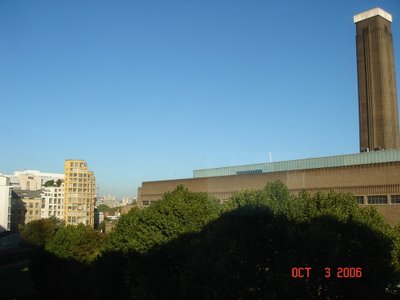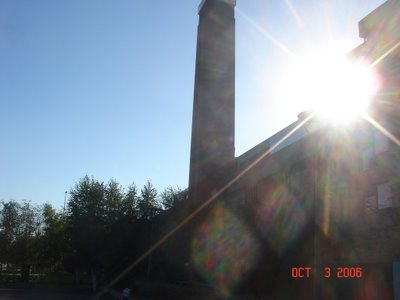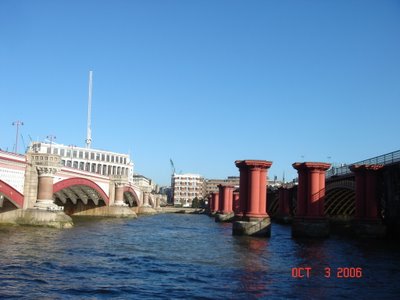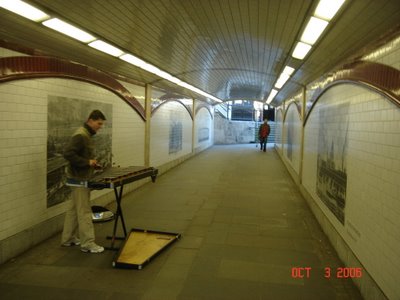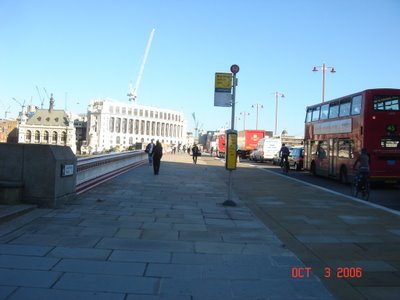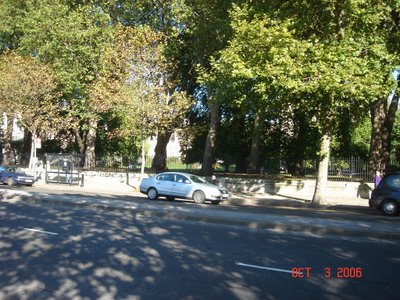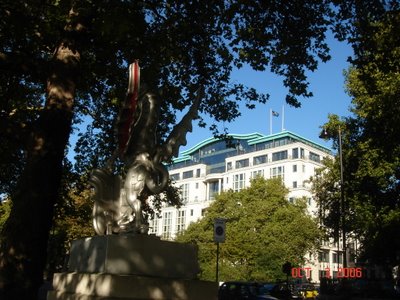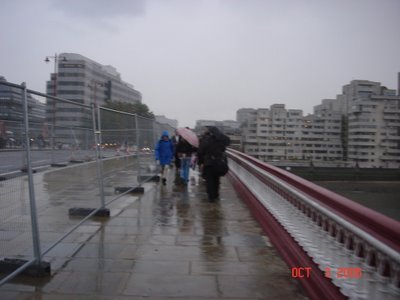Hello again. Sorry for the delay since I my last post. I have had a crazy couple of weeks, and have certainly "hit my stride" down here. Down to the hour, exactly one week from today I will leave Chile and head home for Christmas. In all honesty, this will probably be my last post, as nothing really interesting is going to be happening in the next 7 days and I expect it to be a very busy time. Allow me to start off by saying that this has been one of the most interesting and unique 2 week stretches of my life. Before I go into any description of my travels, I have some other things to write about.
Chile is a very family-oriented society, at all levels of class. . In poorer areas, family ties are important for all the same reasons they are anywhere else. In wealthier families, however, it's unique among my experiences, including my time in India which is also avery family centered place. One thing that is unlike anything I've experienced before is that wealthy families have lots and lots of children. Jaime, a man who works in my office, has 5 children between the ages of 11 and 2. He was the first father I met, and I was impressed by the size of his family. Seeing that I was impressed, he correctly guessed that I didn't know much about Chilean familial ties. He then proceeded to explain, and these numbers are no longer abnormal sounding to me after meeting other people in the month or so since this conversation took place, that his sister is one of 9, her mother one of 8, her father one of 6. She has 72 first cousins (meaning, her grandmother has 72 grandchildren), and her parents have an annual Christmas party for all the first cousins, their spouses, and their children. This is an indoor and outdoor party (don't forget, this is Christmas in the middle of the summer, imagine Christmas in July, I just had Thanksgiving in May and it was lovely)-- and it's a good thing that it's indoor/outdoor, because 250 people come. It's really absurd, and its the opposite of the typical effect of having a successful career in the USA-- here, when you have a good job, like working in the office where I work, you basically settle down and have a kid every 2 years for the next 10 or 15.
So, anyway, all that to say-- Chile is an extremely family oriented place, to the extreme that I've found it very hard to make friends with people. In general, social circles are limited to high school buddies and your immense network of cousins, and the drive to get out there and meet other people just doesn't really exist. While here, my main social interfaces, other than just like walking up to people on the street, are these: I'm working in an office and living with a family.
I really like the people I'm working with, and have enjoyed the time in the office with them. However, it is a small office-- EcoSecurities only has 5 people working here. So, it's a small office, and no one does anything together after work (3 are married), and so no one has really taken me out on the town or shown the initiative to show me around or show me a good time. That's one thing that has been a bit strange to me, people from Santiago are perhaps the least patriotic city people I've ever encountered. Obviously, I'm interacting with a small sample, but in general the idea of "oh, there's this place you definitely need to see," or "there's a great indian restaurant over there," just doesn't seem to be the case here. Either that, or by coming down here alone after everythign that happened, I just seem so independent that it doesn't really occur to anybody that it would have been nice if someone had served as an ambassador and lended a hand. Again, people are extremely family oriented, and I think that's part of it.
So anyway, I come home to my family, where there is a 21 year old girl, 20 year old guy, and 12 year old girl. This, logically, would be where I would be able to reach out to other people my age. But... Jesu, the 21 year old, she just simply isn't very social at all. In the last month, she hasn't gone out with friends once, as far as I can tell. She's perfectly nice, but is definitely not the kind of girl who is going to take me out. Nicolas, her younger brother, is much more social by nature, and is extremely affable. He, however, is currently in between the equivalent of junior college and college, is very serious about his career, and is studying construction engineering. So, he's taking a semester off from school and is working long hours as a construction engineer on a massive Santiago freeway project. I'm not really sure what he does-- he's definitely not a "construction worker"-- but he's working like 60 hours a week, and when he's not working, he is spending time with his girlfriend of two years, Constanza. Thus, Nico hasn't been much of a source of activity either. As I mentioned in a previous post, the simple life that I've been leading down here has been soothing in a lot of ways after an extremely hectic 8 month period on 4 continents with 4 jobs and a big scare. I wake up, go to the gym every day, go to work, work a lot, until 7:30 at least, come home, have dinner with my family, and hang out and wind down with them most of the evening. However, I've had very limited support when it comes to anything that I'd like to do outside of the house or office. This time down here has been a real exercise in independence for me, and I'm not upset about it. I haven't been anywhere near this independent in a long time, certainly not since the first half of freshman year, and even then that was no where near as unsupported as this has been. I am really enjoying the work I am doing and the people I'm working with, and living with this family as well. It's been some very good time alone, just long enough to where I'm very excited to see my family and then friends again, and it's given me time to think about a lot of things as well as enjoy being thrown out of context again. I don't think I have a context anymore. It's not the thing that makes me happiest in the world, but it makes me happy like little else does, in a unique way, to walk down the streets of a city I have no business being in, listening to Johnny Cash or Bob Dylan or Cream.
So, the short version:
3 weeks ago, I realized that no one was going to, for better or worse, go out of their way to take me out and show me this place, and that I wasn't going to meet anyone who was going to travel with me. I accepted this, and decided to do it myself, so I spent the last week of November planning a road trip. After finding the one travel company that would rent a car to a 21 year old, I started looking at maps and reading guide books. Planning a road trip is a really exhausting process, especially if all the places you're going are places you've never been, and if you're travelling alone. After my experience, I have some recommendations:
1) For your sanity, start by making a skeleton-- plan one "can't miss" thing or destination for each day. Plan at least what cities you're going to sleep in, and then fill it in from there. Give yourself at least 20% longer to get anywhere than you think you need, and don't expect to feel like you have a carefully made plan when you hit the road and you'll be fine. When I got the car on Saturday morning, I knew where I was sleeping Saturday night and how I was going to get there, and after realizing that no amount of reading Lonely Planet was going to make me feel like I had any idea where I was going, I set out. It's a lot easier than it sounds.
2) If you're renting a car, and you're alone, consider taking along a little gas can with a few extra gallons of gas, just in case. Also, it's good to have food in the car. And for gods sake, it's a road trip and you have no one to talk to, make yourself some friggin legendary Road Trip Mix CDs. If you're driving in Chile for 10 hours a day, I also recommend that you bring sunscreen.
3) If you're driving through an area, and you look closely at your map and you see that you're about to pass through "La Reserva Nacional de las Chinchillas," the only remaining wild habitat of the Chilean Chinchilla, you must stop. It's a rule.
Okay, so onto the actual post (this is going to be very, very long. I apologize in advance. I've been waiting 2 weeks to write all this down.)
Feel free to open these maps up, if you actually want to follow my progress. All in all, I drove over 1500 kilometers in 3 days. There'll be no need to have the map there, but here they are if you want them:
Northern Map: http://www.turistel.cl/v2/secciones/mapas/ruteros/coquimbo.htm
Southern Map (Starting Point): http://www.turistel.cl/v2/secciones/mapas/ruteros/coquimbo.htm
So, after some planning, on Friday the 1st of November I left work a little early. I came home around 5, threw some clothes in my bag, and went to the grocery store. I thought it would be a good idea to have some emergency food, in case my car broke down, so I bought "Pan", which is bread, but it's more than bread-- it's the staple grain in Chile, every grocery store has a miniature pan-shop where they make bread, and keep it hot, and it's delicious. I didn't like it at first, but I'm used to it now and have sampled some different varieties. I really enjoy the fresh baked wheat bread, with a little cherry jam. But anyway, I got some bread, cheese, fruit, and some big bottles of water. As purely an emergency measure, I bought a pack of hotdogs in case I got stuck somewhere with no protein source. Now looking back, this was pretty ridiculous. I was pretty rarin' to go, and couldn't resist the idea of having an emergencies-only hotdog supply.
I said goodbye to my famiy (María Jesús, Nicolas, Jesu, and Valentina), and hopped on the subway and headed to the bus station. I got on to the next bus to Viña del Mar,
the coastal resort in Chile, about 2 hours to the west of Santiago, and was on my way. I got into Viña at about 9 PM, checked into the first hostel that I found, left my baggage there but locked the door and hid my laptop under the mattress just to be a badass, and headed out for a night on the town. After walking around, an hour later I found myself at a restaurant called Margarita, having a very good burrito and drinking a.... water.
After Margarita, I continued walking around Viña, and around midnight found myself in the municipal casino. There are a few casinos in Chile, and Viña's is the most glamourous. Anyway, nothing really interesting about the casino, other than it seemed to me that everyone was losing and that no one cared-- not in the money-is-no-object way, but rather in the we-always-lose way. Especially with the card games. The dominance of the black jack dealers, it stung my face. I had actually never been inside a casino before, other than the ridiculous casino-ettes in and around the Death Valley area, and I quickly found out that I had very little interest in gambling. Most tables, the minimum bet was 5000 pesos, about 10 dollars. This was a little square pink chip, and most people casually threw a couple of these onto the table at the blackjack table where they were facing, as far as I could tell, a monolith of a dealer. I didn't stay too long, and eventually made my way back across the bay to the other end of town where I was staying. I was walking home on Valparaíso street, when I came across the first of many Teleton parties that I would encounter over the weekend. I stayed here for 2 hours, from 1-3 in the morning, and at 3 there were more people-- old, young, women, kids, etc-- at 3 than at 1.
The Teleton is really deserving of its own post, and one of the most wonderful things about this road trip was that it was an epic journey all over Chile played against the backdrop of the Teleton, which is kind of like... I seriously just sat here for 5 minutes trying to finish that sentence. The Teleton is unlike anything I've ever seen before-- it grips the nation, it's all anyone talks about, it's the Super Bowl--- and it's a Telethon. It's a nationwide fundraising effort for children's hospitals, and it's nothing less than a phenomenon. On TV, Teleton related adds are like midterm elections: "Teleton: Necesitamos todo tu corazón." Imagine if the whole USA did a Relay for Life, and if every down you drove into had signs, banners, in windows and on lamp-posts, and you have some idea. Security guards, with little tvs, at 5 in the morning-- they're watching the Teleton.
http://translate.google.com/translate?hl=en&sl=es&u=http://es.wikipedia.org/wiki/Telet%25C3%25B3n_2006&sa=X&oi=translate&resnum=3&ct=result&prev=/search%3Fq%3Dteleton%2Bcorazon%26hl%3Den%26lr%3D%26client%3Dfirefox-a%26rls%3Dorg.mozilla:en-US:official%26hs%3DCCo%26sa%3DX
This is the Spanish Wikipedia Teletón page. The translation isn't very good, but hopefully you'll get an idea.
So anyway, there was a party in Viña, dancing in the street, with a great band on stage, and I stayed there for a while, enjoying myself much more than I had in the casino. At about 3, I went home, where I was very excited that the 13 dollars I had paid for my night in the hostel included breakfast, and I set the alarm for 6 hours later. I woke up to an admittedly mediocre breakfast, but it had hot coffee and cold pan. In a Chapman-Olive-would-be-proud moment, I took the bread and used it like a cover on the opening of the water thermos, successfully heating up my bread as I drank coffee in my underpants, watching the Teleton. It was on every channel, like a presidential speech in the 1950s. As I got dressed, I changed the channel to CNN, which was describing a huge snowstorm and the "abnormally cold weather" gripping the US, as I continued putting on my shorts.
By 10 AM, I was at (my future nemesis! Read on) Alamo Rent-A-Car, licking my chops, and 20 minutes later I had the keys and was driving. I was very excited, having not been behind the wheel of a car in a while; having finally shaken off the doldrums and made it outside of Santiago city limits, and with my road trip just beginning. I drove back to the hostel, picked up my luggage, and at about 11:30 I was out of Viña and on my way north. I forced myself to wait until on the highway to put my first mix CD in. I made 5, and they were both real and spectacular.
I was also very excited right at the beginning of my trip because this was my first time along the coast of Chile-- Santiago is in the middle of the country, and the seafood on the coast is legendary. So, I pulled over at a roadside stand and had a criminally cheap
marisco empenada in Concón, with fresh squid, and then continued. North I went, through small towns like Quillota and La Calera, on my way to La Ligua.
So, once actually IN La Ligua, I parked the car, got out, and promptly continued eating myself into the next century by going to Lihuen Heladeria, which had been highly recommended somewhere. I asked for a little taste-piece of the raspberry ice cream, and promptly bit into at least the 2nd best, if not the best, ice cream I'd ever had in my life. I sweet-talked the owner, he gave me a taste of literally every flavor, and then I had a double, asked for it in a cup, and was pleasantly surprised when they stuck the cone on top anyway. Why don't they do that at home? I got two flavors-- Chirimoya and Swiss Chocolate, and was in heaven. There was another Teleton party in La Ligua, this one at 2 in the afternoon, still going from the night before. I continued on my way.
La Ligua is famous for its dulces-- little cakes with Manjar in them. La Ligua's dulces, you should be thinking Baltimore crabcakes, Cape Cod Clam Chowder, that sort of association. These plump little women stand bravely at the side of the highway with a basket of these things, and they frantically wave this long white flag. I pulled over on my way out of town, of course, with ice cream still on my face (!) and said hello. I asked for 1 sweet (hey, I already had a car full of hotdogs), and I offered her a 5,000 peso bill ($10) She looked at me like I was crazy, and told me she couldn't change it. Remember-- this is the same amount of money that was the minimum bet at any cards table at the casino, only midnight the night before, where I was watching people lazily throw this away, and she looked at me like I had tried to buy a pack of gum with a 100 dollar bill. Pretty striking. Anyway, I apologized and told her that the smallest I had was a 1,000. She smiled, said don't worry about it (the way you might say "it's okay, keep the change"), which struck me as weird.... until she then proceeded to stuff about 35,000 dulces in a bag and waved me on. It was actually 6, but it was 6 times more than I was going to buy originally. A big fat slob, I continued on my way, feeling at this point like the very hungry caterpillar. Turns out, the sweets are very good. Unique-- the cake itself is bitter, but the filling is intensely sweet and creamy, so it's an interesting contrast. Each of the 6 had an entirely different look. I ate about 3 over the course of the next hour on my way to the Chinchilla reserve, and then couldn't even look at the bag anymore, so I tucked it in to the back seat and wondered what I was going to do with it. More on that later.
For map purposes, I continued North, La Ligua to Los Vilos, then going north-east through Illapel until I reached the Chinchilla Reserve in the late afternoon. I stopped at the ranger station, which has a "Nocturama": a humongous indoor Chinchilla habitat where day and night are reversed (Chinchillas are nocturnal), and so at 4 in the afternoon I was in the height of the Chinchilla day, watching them under low red light as they were absolutely crazy, including I also saw a mother Chinchilla with 5 fluffballs. I talked to what must be the world's foremost Chinchilla expert, the park ranger at this reserve, for like 30 minutes, about all things Chinchilla. Key breakdown: They live in families, each family has territory, and they usually have about 8 chinchillas per family. Chinchillas have, literally, the softest fur in the world, according to some objective measure, and have 20,000 hairs per square inch. We have one hair from each follicle-- they can have up to 15. They are also locked into an epic, never ending battle for resources with some desert rat, which is dramatically represented on the food-web in the ranger station by a mutual arrow between the chinchilla and the rat, prompting the famous Chilean parable, "Hey, it's a Chinchilla-eat-Rat world out there." I thoroughly enjoyed this man's company, and we just visited after all my questions were answered. He was born nearby (there is NOTHING nearby.) and grew up in the area (there is NOTHING in the area.), and is generally happy. After our conversation, a lightbulb went off: I offered him one of my remaining dulces, which he was only too happy to accept, and I went on my way, continuing north to Ovalle. Having been taking my time all day, I finally succeeded in getting myself extremely lost somewhere between Combarbalá and Monte Patria. At this point, I am about 4 hours driving away from La Ligua and her famous sweets. I pull over the car and ask a nice-looking man for some directions, telling him I'm on my way to Vicuña. He is very helpful, and afterwards I offer him another one of my sweets. I'm really enjoying this (have you read that Dave Eggers book?) and this one was really fun, because he totally didn't see it coming. Remember, I'm a pretty good distance from La Ligua at this point. Offering someone a fresh sweet from La Ligua in this situation would be like if you were walking around in Maryland and some guy pulled over, asked for directions, and then gave you a fresh cheesesteak from Philly that he had just happened to pick up on the way down. I'm basically convinced it made his day. I finally pulled into Ovalle at 8PM, about 3 hours behind schedule. No worries, I thought, because I'm only 120 kilometers from Vicuña, my final destination. I pressed on, eating dinner in the car (Pan and Cheese, saving the hot dogs for the emergency I knew was coming), continuing to listen to great music, and making good time on my way to Vicuña, until the pavement ran out. With about 50 miles to go.
3 hours later, I pulled into Vicuña. This driving was actually some of the most fun driving I've done in a long time, but it was not fast. At this point, I've gone from the lush central valley to the arid "Norte Chico" where lives the fierce Chilean Chinchilla, but now I'm entering a valley region that is one of the centers of wine-grapes in Chile. All of the sudden, it's beautiful and green again, and I'm driving on a dirt road in Chilean wine country, through small towns, composed entirely of people who pick grapes for a living, and the sun is setting. All of the sudden, I'm in one of those towns small enough where you naturally wave from the steering wheel and get a wave back. Here, in the first couple of towns, I saw some intensely, almost unsettlingly beautiful women, walking down the side of the road in this idyllic setting. Dark, dark hair and eyes, beautiful skin, simply some of the most beautiful women I've ever seen, the kind you want to just pull over and say "Marry me, we'll have a vineyard and tanned barefoot children with white teeth and dusty faces and fresh, green chili salsa with cilantro. I'll read you Borges. I'll read you Borges in Spanish.
Please."
After the sun went down, it was just me and this intensely winding road, for about 2 hours, making me realize that I had forgotten how much I like driving. Finally, I arrive in Vicuña, about 380 miles from where I started. Vicuña is a very small town 2,000 people or so, nestled in the heart of the Valley Elqui, a grape-growing powerhouse. The only reason I decided to come to Vicuña, although I'm now glad I did for other reasons, was because it is the site of several scientific astronomical observatories. As a thank you to the town for its efforts to reduce light pollution, these observatories put some money together and donated a relatively small facility for the municipality, for tourism purposes. The science ones are, (world wide and as a rule), basically never open to the public. Observatorio Mamalluca (don't ask), however, was built precisely to be open to the public. One thing I had been excited about for coming down to South America was to see a whole new set of constellations, but Santiago is so massive that you can't really see anything. So, Vicuña is one of the best places to go to see the stars in the whole world, so I made it my destination. I arrived Saturday night and checked into another hostel, recommended by my guidebook ("Owners are perfectly civilized"). This time, however, I really had an unexpectedly delightful time. The owner, Ricardo, and I hit it off immediately. He's an old Argentine, and was just a lovely person. We sat up until 2, talking, in his beautiful hostel. I'm sad to say that I didn't take any photos of it. It rains so infrequently that the sitting room of the hostel simply has no roof. So, we sat there, under the stars, chatting, and finally I went to bed exhausted. The next morning, Ricardo cooked me a delicious breakfast, with literally perfect eggs. At that moment, I decided I would stay with Ricardo another night, and he repeated this feat the next morning-- perfect eggs. "These eggs are perfect, Ricardo." "Thank you. You know, there's just a point, you have to be able to see it."
After sleeping in late and then breakfast and more talking with Ricardo, I got up and went to the observatory's office to make an appointment for late that night, and having secured this, I got in the car (emergency food supplies still holding out!) and at about 1 in the afternoon I headed east. The road east doesn't really go anywhere. After an hour in the valley, it forks. The south fork runs out, and the north fork is a pass into Argentina that is closed 10 months of the year due to snow. It's a 5,000 meter high pass, called "El Paso de Agua Negra." I'm pretty sure that's the manliest thing I've ever heard. It would be nice to get up there with an empty bottle, so you could bottle liquid manliness. Anyway, first I went south, to a little town called Pisco Elqui, known as the birthplace of Gabriela Mistral (Nobel prize winning female poet). I made an appointment to tour a Pisco distillery called Tres Erres, which is a famous brand in Chile. Pisco is the national liquor of Chile. It's made from grapes and is extremely strong, up to 90 proof. It has a unique taste, like a grappa but slightly different. Pisco experts drink it on ice, or even better, straight but cold, keeping the bottle in the freezer. Normal people drink Pisco Sours, which are generally sold pre-mixed but can be made at home. They're made with 2 parts pisco, 1 part lemon juice, and powdered sugar. Also, most people use a little egg-white to make them foam a little. It's kind of like people who drink Gin martinis, and people who drink gin and tonics. While waiting for my tour at 3R, I went to another distillery, called Fundo Los Nichos, which was of an entirely different stripe. Tres Erres is small, but nationally known and nationally available. It's on the shelf of the grocery store in Santiago I go to. Fundo Los Nichos is much smaller than this-- they only sell out of their little bodega at the entrance to the distillery. It's the oldest distillery in the Elqui valley, founded in 1853, and only 6 people work there. Everything is done by hand, and it's a really cool spot. It is called "Fundo Los Nichos" because the original owner intentionally spread stories that there were ghosts in the cellar to prevent people from sneaking in and stealing the Pisco. I talked to the woman working there for a while and then headed over to Tres Erres, where I took a tour of the distillery itself. Earlier on my trip here, I had the opportunity to tour a wine vineyard near Santiago, which was a very cool experience, and this was interesting as well. I bought a bottle to bring home of Tres Erres most lauded Pisco, which is aged twice as long as everything else. I'm going to take it to New York, and share it with some idiots I know.
North: I drove towards the paso de agua negra for a few hours, relishing the change in scenery. I'm more and more aware as I write all this down how inadequate a job I'm doing of describing all of the notable things that I saw. One of them that is perhaps the hardest to describe is the change in vegetation that occurs as you drive through Chile. Since it is so vertically oriented, and is bordered by the ocean on the west and some really intense mountains to the east, Chile's climate changes extremely rapidly as you move from north to south. As I was driving, every hour it felt like I was in a completely different ecosystem. From the fertile central area of Santiago, to the arid Chico Norte, into lush valleys fed by Andean Snowmelt, arid again but a different, scrubbier kind of desert much like Idaho, I finally ended up in Vicuna, which was extremely lush and beautiful. As I drove east, however, towards and up into the Andes proper, the change was even more sudden and breathtaking. As I climbed in elevation and entered the mountains, all of the sudden I was in an extremely dusty, vertical, geologically interesting area. I was the only car on the road, and was driving up this drainage for about 50 miles, alone, as the mountains got more and more impressive. A little higher, and to my surprise the valley widened and there was rdera sizeable stream as I drew nearer to the b. Finally, I reached a point where I could actually see the high mountains that separate Chile from Argentina at this point in front of me, all colors of amber and grey and covered with snow, like a fortress. Soon thereafter, the carabineros had a station and said I needed to turn around, so I did. The sun began to settle in front of me as I made my way back west towards Vicuna, slowly snaking my way out of the Cordillera, and though I knew it was coming, the transition from this high, brutal clime to the idyllic green Valle Elqui was no less shocking the second time. I returned to Vicuna just in time to stop by and say hello to Ricardo, drop some things off in the room, and walk over to the Observatory's office, where I waited for the bus that took me the 10 miles up the wall of the valley to the observatory. I spent Sunday night at the Observatory, looking at the southern constellations. It was a full moon, which was a bummer in some ways because it was too bright to see some of the smaller, more dim clusters, but this was somewhat trivial as the observatory's telescope is not very powerful by scientific observation standards. Highlights included watching Sirius, the brightest star there is, rise over the neighboring mountain ranges. Sirius is much brighter than Polaris, the north star, which appears brightest in the northern hemisphere due to the fact that Sirius, where visible, is at an extremely low angle. It was quite a sight. The moon, however, was truly a spectacle, and I got to look at a full moon at 100x magnification. I took some pictures through the telescope with my camera, which worked surprisingly well, and these pictures are part of the photo album that I will eventually upload with photos from these journeys I took. I was up at the observatory until late, and then came home and went to bed. Sunday was a very low-key day in between two days of a lot of driving, but one in which I managed to go up into the Andes, visit a very cool Pisco town, and see the stars and moon at one of the best places on Earth. I recommend having a day like this in between. Saturday, I saw so much, and took in so much of the landscape, it was almost overwhelming, and having 3 days like that in a row would have blunted the whole experience. Monday morning, I got up early and had a good long talk with Ricardo and a second perfect breakfast including the best avocado I've ever had. This wasn't one of those times like when you go somewhere specifically to have the best ____ you've ever had, and you get hyped up which is half the fun, and then the hype and the good food kind of mix in your mind. This was totally unexpected, just sitting there on the table, sliced up, and it blew me away. Ricardo and I exchanged email addresses and said our goodbyes, and I headed out to the car.
That's when I realized that my car had been broken into sometime the night before. This was the only low point of my road trip. The casualties: The faceplate of the CD player and my rental car agreement, which I gleefully brushed off (thinking at the time that I wouldn't have to pay for it). After congratulating myself for keeping all my valuables with me in my luggage, I realized that I had left my grandfather's 35 year old aviators, the original Ray Bans, in the car, and that they were gone. I chalked it up as a casualty of just flinging myself out there like this and got in the car and drove away. The drive out of Vicuna Monday was very different than the drive out Sunday, where I had been driving east, wearing my aviators and blasting music on the stereo. This time, I drove west, squinting in the daylight, listening to music on my iPod, and thinking about what a big idiot I was. However, things could have been much worse-- inside was my passport, my camera, my laptop, and other things of import. If any or a combination of those things had been left in the car and then taken, I would have probably never forgiven myself. The thief, having ransacked my car, took my sunglasses, the rental car agreement, and Road trip mixes 2 and 4. He passed over, however, on my sunscreen and discs 1,3, and 5. So, if you are ever in a little Chilean town called Vicuna, and you see a guy with pretty amazing sunglasses but a sunburned nose and a penchant for even numbers, be sure to shoot him a thumbs up for me. Onward and westward!
I continued to La Serena, "the" big town of the Norte Chico. Having been told that it was great, I forced myself to drive around for 20 minutes before deciding it was really boring, and then I got on legendary Ruta 5, (think Route 66), the Pan Americana, which is part of a highway all the way from the southern tip of South America to Alaska. In Chile, the PA snakes along the coast. Both La Serena and Vina del Mar are on the ocean, and I designed my route so that I could see two different sides of the country by taking the interior roads on my way up and this iconic highway on the way back. I saw a lot more of the ocean on my way home, but I also drove a lot faster. After several hours on unpaved roads, the speed of a highway is a little unsettling. I blasted out of La Serena at almost 80 miles an hour, listening to some of those great tunes I won't shut up about, and barreled south, tangent to the ocean with the windows down.
For an idea of the music I was listening to, here's the tracklist of one of the CDs. This is Disc 5:
1) Head Home, Midlake
2) Rocks Off, The Rolling Stones
3) Off The Record, My Morning Jacket
4) Under the Bridge, Red Hot Chili Peppers
5) Portland Oregon, feat. Jack White, Loretta Lynn
6) California Waiting, Kings Of Leon
7) Runnin' Kind, Merle Haggard
8) She's Not There, Santana
9) High And Dry, Radiohead
10) No More Birthdays, Sound Team
11) Scuttle Buttin', Stevie Ray Vaughan & Double Trouble
12) Baltimore Johnny, The Del McCoury Band
13) Torture Me, Red Hot Chili Peppers
14) Clocks, Coldplay
15) Ain't No Easy Way, Black Rebel Motorcycle Club
16) The Bends, Radiohead
17) Where The Streets Have No Name, U2
18) Such Great Heights, The Postal Service
Monday was a driving day, as would be expected by spending it on the highway rather than the smaller roads, where I made innumerable little stops that were fun but aren't worth writing about. (Some of them may or may not have been executed simply so that I could leave the car door open, turn up the volume, and dance the jig in a particularly jig-worthy spot.) I decided, therefore, that I would make one big stop between La Serena and Vina del Mar, taking in the rest of it from the car. I made my stop in Guanaqueros, a small and ancient fishing village on the Pacific coast. I ended up staying there for 3 hours or so, really taking the time to explore and get a feel for this little spot. It was the only little town where I took many photos, and my photos of dogs in Guanaqueros will have to serve as ambassadors for the rest of the true characters that I encountered on my travels. Guanaqueros is, like many communities in Chile, cut into hillsides. The hills run basically right into the ocean, so as the community grew (it didn't grow much, it's tiny, but I'm guessing the first houses were right on the water), successive rows of homes were cut into the steep hillside. The roads are thus parallel to the beach, and all the houses face west, looking out into the ocean. The hillsides are so steep, in other words, that there aren't two sides to every street. The street is cut into a terrace a level above the previous row of houses, so that if you stand on the road and look towards the ocean, you could literally step from the road onto the roof of the house on the level below. It's like stadium seating, basically-- the back of everyone's house is dug out of the ground, and no one has eastward windows. It was a perfect day, clear and a little windy, and I got the impression that there was a healthy community of old folks in Guanaqueros. I walked around this radially symmetrical city, radiating like a seashell uphill around the main ocean dock, and found every house with windows open and simple fabric curtains. Lots of people were listening to the radio, to a soccer game, enough so that acontinual-broadcast was in effect-- as I walked, it was like having a radio with me as I passed from house to house. After a little while, I decided to head into a restaurant and have some of the seafood Guanaqueros is famous for. Since I had never been before, and will likely never be again, there was realistically no way to decide which restaurants would be good and which wouldn't. There were a few to choose from, and so I just decided to go to a place called "Los Buenos Muchachos", deciding it would make a good story either way. Well, the name on the sign was a lie, because there was only one buen muchacho working at los buenos muchachos (other than a very lazy spaniel of some kind, sleeping on the porch, who must have been the other. He certainly qualified.) When I walked in, the place was empty, and el soltero muchacho was watching TV. He asked me if I wanted lunch, and I said yes please. He asked if I would have the plate of the day, and I said oh, yes, of course. He then got up and went into the kitchen and started making it. I sat down and started thinking about christmas presents, and I swear that guy spent 30 minutes making my lunch. When he brought it out, it knocked my socks off. Very simple, fresh, fried fish, with good vegetables. One of the best fish dishes I've ever had. I was now in awe, in disbelief at my good fortune at choosing such a place. After the meal, I asked this nice old man what he had served me. When he responded, he said enough words that I realized that he had almost no teeth. I also realized that I couldn't understand a damn word he was saying. So, I went to a small, remote fishing village in Chile, waltzed into a restaurant with a misleading title, had the best fish of my life, and its name will forever be a mystery to me because the cook/waiter/owner had no teeth and I couldn't understand him. Maybe it's better this way.
After leaving Guanaqueros, I basically made my way all the way back to Vina Del Mar, taking Ruta 5 most of the way and then, when it veers inland to go to Santiago, I took a smaller highway that really hugged the coastline for the last 50 km or so. I arrived back at the rental place, explained what happened with the radio, was shocked to find out that I had to pay for a new one, and had a completo and made my way back to Santiago on the bus again. Final tallies: 3 days, over 1500 kilometers, and finally some idea of what chile looks like. The experience, as a whole, of finally deciding to just road trip it by myself and then launching into it, is something I'll never forget. It makes me want to come back and spend a summer in a car in South America. For that, however, I would certainly need a partner in crime.
A completo, what's that you ask? A completo is the fast food of choice in Chile, functioning a lot like a single slice in new york. A completo is a hot dog, but elaborately presented. Basically, a completo is a hot dog in a too-big bun that is full of other things. You put all the other ingredients in the bun and then throw the whole contraption on the grill, to allow everything to heat up, mix, and the like. It's pretty delicious, and I'm excited to know about the Completo as a platform for future experiments. I've never seen a hotdog re-grilled in the bun before, but it makes a lot of sense. My favorite completo is "The Italian", so named because of the colors of its ingredients-- diced tomatoes, fresh avocado, and a little mayonnaise.
I got back to Santiago at about Midnight Monday night, made my way back to my house, and collapsed into bed. I went to work on Tuesday, worked all day, and then Wednesday morning I got up and got on a plane to go to the South for another short trip, this one being for business Wednesday and Thursday and then more exploration Friday through Monday morning. I think I'm going to save my description of that trip, which included a 2 day solo backpack in the Patagonian rainforest, for another post. For now, I'll conclude here with some unrelated observations and notes.
I've discovered a few other things that I really like about the Spanish language. One of them, probably my favorite new thing, is that Spanish is very word-economical, to an almost philosophically meaningful degree, when it comes to related concepts. As an example, the way that Spanish says things like "ice cream," "ice cream maker," and "ice cream store." Those things, in order, are helado, heladero, and heladeria. Maybe you see where I'm going with this, but I think it's really great that professions, places of business, and the thing being produced are so simply, deeply, and elegantly related, and that they all only have one word. We used to have words like this in English, but they are now old-fashioned and never used anymore. Vender is to sell, so a guy working at a shoe store is just called a "Vendedor." He's not a "retail team-member", he's not a "sales associate." He's a seller. We used to do this, by appending "smith" on the end of everything-- blacksmith, silversmith, etc, but these aren't used anymore. Here, Cafe means coffee, so Cafeteria means, you guessed it, Coffee Shop. Any idea what a Sandwicheria might be? Botelleria? I like the latter-- a botilleria is a liquor store, but the word makes it more like "bottle shop." Pescaderia, etc. We have one thing similar-- you can still find a "Hotdoggery" in some cities, but imagine if there was a single word, like Hotdoggery, for every single kind of store! It's really the best.
Also: Manzana is apple. Manzano is apple tree. Naranja, Naranjos, Palta, Palto. I like that as well.
In Chile, every bridge, no matter how small, has a name. "Puente O'Higgins." I think this is really cute, similar to how small towns in Missouri all have their names proudly painted on the water towers. "Billings"! And, if its a REALLY small town, it also (this is kind of embarrassing) simply HAS to have the town's high school mascot on the water tower. This is a delicate balance, however, because it has to be a pretty small town to be that hyped up about high school sports, but it has to be big enough to have a water tower big enough that the words "Aurora, Home of the Houn' Dawgs" will fit on there. (That, by the way, is a real place, in Missouri about 40 minutes from my house, and that's really their mascot, apostrophe and d-a-w-g-s included. Look it up.)
Bathrooms here, they say "Damas" and "Varones". This, loosely translated, means "Dames" and "Roosters." I like that as well.
Thanks for reading all this. I hope it was at least somewhat interesting. As a conclusion, here was my favorite thing about my trip:
When I got to the Valle Elqui, the most celebrated Pisco district, I was immediately stricken by a couple of things. First, I think there is something very charming about a place that is, for all intents and purposes, wine country, but whose product is something that is basically a working-man's liquor, both strong and fast-acting. It had all the cool things about wine country-- idyllic landscapes, rolling plantations, fascinating local economies-- but with none of the bullshit and a healthy dose of working-class ethos. It's a less snobby version, and it's much more appealing. Plus, it's humorous that these people are growing something so strong. While wine is tame and flavor is the main focus, growing pisco grapes is like having a farm of whiskey-trees.
The other thing though, and this was an image I'll never forget, is that as I drove down into Pisco Elqui on Sunday and peered down into the valley from the road, I realized that everything built by people-- houses, roads, businesses-- they were all up on the walls of the valley. In this area, the soil is very fertile, so the determining factor is water. Where there is water, it is lush, thick, green. Without water, however, it is extremely arid and scrubby. Thus, these Pisco valleys were really cool because the valley floor was the very picture of agriculture, but the walls of the valleys looked like Idaho. So, water flows down the valley floor, and as a result (these are glacial valleys, so they're wide and flat), the area between the walls of the valley is beautiful and extremely productive. And, you see these human establishments, pushed up onto the walls of the valley, and all of the sudden its obvious-- it reflects the fact that the valley itself is the main event, pushing everyone else to the margins. The farmers, respectful of the productivity of the valley, don't waste good land with houses, yards, etc, so their houses can be found, almost reverentially, in a giant circle, elevated, enclosing the valley and grape production. So, the valley itself is like a big theater in the round, and the way the perhaps-subconscious urban plan reflected the livelihood of the people was really special to see.
